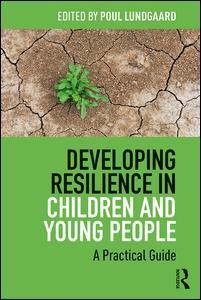Description
Developing Resilience in Children and Young People
A Practical Guide
Author: Lundgaard Poul
Language: English
Subject for Developing Resilience in Children and Young People:
Keywords
Young Man; child and adolescent psychotherapy; ToM Competence; resilience; Liverta Sempio; Anna Freud Centre; Common Language; Susanna de Lima; Uninvited Guests; Annalisa Valle; Resilience Programme; Davide Massaro; Autism Spectrum Disorders; Ilaria Castelli; Brain’s Alarm; Francesca Sangiuliano Intra; Vice Versa; Elisabetta Lombardi; ToM Ability; Edoardo Alfredo Bracaglia; ToM Development; Antonella Marchetti; Brain’s Alarm System; Heidi Moeller Vestergaard; Resilience Program Training; Lene Elmose Broecker; Alarm Center; Peter Skaarup; False Belief Tasks; Dan Henriksen; Mentalizing Approach; Lene Steensberg; Remote Control; Nina Lykke Nielsen; Good Life; Tine Kaarup; Children’s Wellbeing; Jeanette Corneliussen; Resilience Instructors; Tina Brammer Kristensen; Volume Button; Mette Bentzon; Emotion Regulation Strategies; Helle Fogtman Welejus; Children’s Mentalization Abilities; Lotte Dalager; Helicopter Perspective; Gritt Graugaard Bonde; ToM Task; Joan Dammeyer; Louise Lundgaard; Mette Haahr; Johanne Cecilie Andersen; Morten Lysdahlgaard
Publication date: 03-2018
· 15.6x23.4 cm · Paperback
Publication date: 03-2018
· 15.6x23.4 cm · Hardback
Description
/li>Contents
/li>Readership
/li>Biography
/li>
Developing Resilience in Children and Young People: A Practical Guide is the first book to describe the work of professionals using the world?s first mentalisation-based mental health education program ? Lundgaard?s Resilience Programme. Bringing together accounts from those working with children, young people and parents across many disciplines, this book outlines how they tackle the core issues of self-control, self-esteem and self-confidence with their clients using the tools and knowledge derived from the programme.
Resilience means being able to handle the challenges of life, especially when life is hard, and The Resilience Programme is unique in its simplicity, efficiency and flexibility. The work presented in the book is based on the fact that mentalising ? careful and reflective thinking ? often is very helpful when coping with difficult challenges. The chapters in this book provides practical guidance on how to start working with the programme, how to develop resilience in young people, and even how to create resilient communities in a school for children with special needs.
Developing Resilience in Children and Young People is written for those professionals who interact with children and young people on a daily basis, and will become an important book for mental health professionals.
A practical guide
to teamwork with children and adolescents
Poul Lundgaard Bak (Ed.)
Table of contents:
Introduction
Chapter 1
What is Resilience? – The Background of tThe Resilience Programme
Poul Lundgaard Bak and Susanna de Lima
Chapter 2
Experiences and results of the Resilience Program for primary school teachers in Italy
Annalisa Valle, Davide Massaro, Ilaria Castelli,, Francesca Sangiuliano Intra,
Elisabetta Lombardi, Edoardo Bracaglia and Antonella Marchetti
Chapter 3
Stories and Valuable Questions – Experiences from Health Care
Heidi Moeller Vestergaard and Lene Elmose Broecker
Chapter 4
Resilience at School
The First Experiences
– Resilience for Schools and Children’s Groups
Peter Skaarup
Experiences with Resilience in a Socially Disadvantaged School
Dan Henriksen
Luxury Issue? No, Iit’s Nnot
Lene Steensberg
Chapter 5
Being Llike the Others – Resilience for Children and Adolescents in Club Activities
Resilience in a Socially Disadvantaged Residential Area 1
Nina Lykke Nielsen
Resilience in a Socially Disadvantaged Residential Area 2
Tine Kaarup and Nina Lykke Nielsen
Dreams for the Future
Jeanette Corneliussen
Resilience
- ‘Only for Paki’s?’
Tina Brammer Kristensen, Mette Bentzon and Helle Fogtman Welejus
Resilience in a Youth Perspective
Lotte Dalager
Chapter 6
Resilience for Teenagers in Therapy
A Course for Vulnerable Youths with Drug Abuse Issues
Susanne de Lima with contributions from Lotte Dalager
Cooperating Wwhen Iit’s Difficult
Gritt Graugaard Bonde
Chapter 7
Appropriate Challenges in a Special Needs School
Joan Dammeyer
Chapter 8
‘Will Yyou Hhelp Mme?’ – Experiences from a Children’s Home
Louise Kristensen and Mette Haahr
Chapter 9
A Municipal Perspective on Resilience
A Municipal Perspective on Resilience I
Johanne Cecilie Andersen
A Municipal Perspective on Resilience II
Morten Lysdahlgaard
List of Figures (= Figure Texts):
Figure 1.1: Thought bubbles
Figure 1.2: Attention – Spotlight of the brain
Figure 1.3: Focues attention
Figure 1.4: The Thinking Brain and the brains Alarm Centre
Figure 1.5: The Mind game
Poul Lundgaard, MD, Senior Physician, has 25 years of experience working in mental health promotion, especially with children, young people and families. He is the founder of The Resilience Program and is engaged in research building up the evidence base around the program.
These books may interest you

Handbook of Resilience in Children 316.49 €



